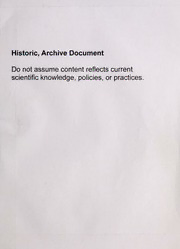Table Of ContentArchive Document
Historic,
Do assume
not content reflects current
scientific knowledge, policies, or practices.
aTX537
.G46
Pt.7
HACCP
USDA
Generic
Model Thermally
for
United States
Department of
Processed
Agriculture
Food Safety
Commercially
and Inspection Sterile
Service
April 1997 Meat and Poultry
HACCP-7
Products
>\
United States
Department of
Agriculture
National Agricultural Library
Table of Contents
Introduction
1
HACCP
Principles of 1
Principle No. 1 1
Principle No. 2
1
Principle No. 3 1
Principle No. 4
1
Principle No. 5 1
Principle No. 6 2
Principle No. 7 2
Definitions 2
Corrective action 2
Criterion 2
Critical Control Point (CCP) 2
Critical limit 2
Deviation 2
HACCP
2
HACCP
Plan 2
HACCP
System 2
Hazard 2
Hazard Analysis 2
Monitor 3
Preventive measures 3
Process 3
Development of the Plant Specific HACCP Plan 3
Description of the Product 3
Process Flow Diagram 3
Hazard Analysis 4
Critical Control Point (CCP) Determination 5
HACCP
Plan 5
Steps for Selecting a Generic Process Model 7
Process Platform for Use of Generic Models 7
Model Plan for Process Thermally Processed/Commercially Sterile 9
i
Hazard Analysis 9
CCP
Decision Tree 11
Preparing Your HACCP Plan 12
Process Description Form Beef Stew 13
Product and Ingredients Form 15
Process Flow Diagram 17
Process Flow Diagram - Beef Stew 18
Hazard Analysis/Preventive Measures Form Beef Stew 19
CCP Determination Form 22
HACCP Plan Form 27
Process Description Form Pasta Sauce with Meat (Acidified Product) 38
Product and Ingredients Form 40
Process Flow Diagram 42
Hazard Analysis/Preventive Measures Form Pasta Sauce with Meat 44
CCP Determination Form 48
HACCP Plan Form 53
Appendix 1 - List of Process Models 58
Appendix 2 - Flow Chart for Generic Models 59
Appendix 3 - Food Safety Hazards 60
ii
Appendix 4 - Hazard Analysis: Thermally Processed/Commercially Sterile 61
Incidents of Foodborne Illnesses from Thermally Processed, Commercially Sterile
Canned Product 63
Product Spoilage in Thermally Processed, Commercially Sterile Food Products ... 67
Physical and Chemical Contamination 72
Sources for Epidemiology of Foodborne Illness 76
General 76
Products Spoilage in Thermally Processed, Commercially Sterile
Food Products 76
Physical and Chemical Contamination 78
Attachment 1 - Examples of Questions to be Considered in a Hazard Analysis 79
Introduction
The Hazard Analysis Critical Control Point (HACCP) concept is a systematic, scientific
approach to process control. The Food Safety and Inspection Service (FSIS) views HACCP
as a means of preventing the occurrence of health and safety hazards in plants producing meat
and poultry and their products. It does this by ensuring that controls are applied at any point
in a food production system where hazardous situations could occur. These hazards may
include biological, chemical, or physical adulteration of food products.
The United States Department of Agriculture (USDA) published a final rule in July
1996 mandating that HACCP be implemented as the system of process control in all USDA-
inspected meat and poultry plants. As part of its effort to assist establishments in the
HACCP
preparation of plant-specific plans, FSIS determined that a generic model for each
process defined in the regulation will be made available for use by the regulated industry.
HACCP
In addition to the generic model, background information on is included to
assist an establishment in conducting a hazard analysis and developing a plant-specific plan.
The regulation includes specific references to the development and maintenance of
standard operating procedures for sanitation, and these standard operating procedures should
HACCP
be in place before a system is implemented. For this reason, principles of good
HACCP
sanitation are not included as part of the plan.
HACCP
Principles of
The foundation of HACCP can be found in the seven principles that describe its
functions. These seven principles are:
Principle No. 1: Conduct a Hazard Analysis. Prepare a list of steps in the process
where significant hazards occur, and describe the preventive measures.
Principle No. 2: Identify the Critical Control Points (CCP's) in the process.
Principle No. 3: Establish critical limits for preventive measures associated with each
identified CCP.
Principle No. 4: Establish CCP monitoring requirements. Establish procedures for
using the results of monitoring to adjust the process and maintain control.
Principle No. 5: Establish corrective action to be taken when monitoring indicates
that there is a deviation from an established critical limit.
1
Principle No. 6: Establish effective recordkeeping procedures that document the
HACCP
system.
HACCP
Principle No. 7: Establish procedures to verify that the system is working
correctly.
Definitions
HACCP
Definitions ofcommonly used terms are included below to clarify some of the
terms used in reference to HACCP, hazard analysis, model development, and the development
of the plant-specific plan.
Corrective action. Procedures to be followed when a deviation occurs.
A
Criterion. standard on which a judgement or decision can be based.
A
Critical Control Point (CCP). point, step, or procedure at which control can be
applied and as a result, a food safety hazard can be prevented, eliminated, or reduced
to acceptable levels.
Critical limit. The maximum or minimum value to which a physical biological, or
chemical hazard must be controlled at a critical control point to prevent, eliminate, or
reduce to an acceptable level the occurrence of the identified food safety hazard.
Deviation. Failure to meet a critical limit.
HACCP. Hazard Analysis and Critical Control Points. A process that identifies
specific hazards and preventive and control measures to ensure the safety of food.
HACCP HACCP
Plan. The written document that is based upon the principles of and
that delineates the procedures to be followed to ensure the control of a specific process
or procedure.
HACCP HACCP HACCP
System. The plan in operation, including the plan itself.
Hazard (Food Safety). Any biological, chemical, or physical property that may cause
a food to be unsafe for human consumption.
Hazard Analysis. The identification of any hazardous biological, chemical, or
physical properties in raw materials and processing steps, and an assessment of their
likely occurrence and potential to cause food to be unsafe for consumption.
2

